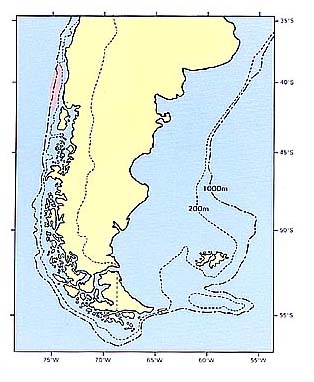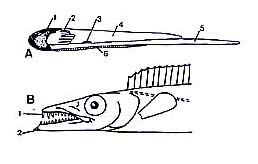タチウオ科
- HOME
- デジタル図鑑
- パタゴニア海域の重要水族
- 硬骨魚綱 スズキ目
- タチウオ科
タチウオ科(Trichiuridae)

111 クロタチモドキ(Kuro-tachimodoki)
Aphanopus carbo Lowe, 1839
特 徴:
背鰭40棘,57軟条,臀鰭1棘,52軟条,胸鰭12軟条,腹鰭0,鰓耙数5+1+17=23,鰓条骨数7。頭長は体長の20.3%,眼径は4.0%,体高は8.6%,吻長は7.9%,両眼間隔は3.8%,上顎長は9.3%,尾柄高は0.5%,胸鰭長は9.0%。体は顕著に延長し,著しく側扁する。頭は中庸で,体長は頭長の約5倍。頭部に冠状隆起が発達しない。口は大きく,ゆるやかに湾曲し,上顎後端は眼の中央下に達する。下顎は上顎より前方に突出する。吻は長く,頭長は吻長の約5倍。眼の上縁は頭部背縁を形成する。鼻孔は1つで,三ヶ月型。両顎歯は鋭い三角形で1列に並ぶ。上顎前端に3本の返しのない大きな牙状歯がある。第1鰓弓の鰓耙はコブ状で,内側に微小棘を有する。胸鰭は短く,ほっそりしている。腹鰭はないか,あるとしても痕跡的。第1背鰭基底は第2背鰭基底よりも短い(これはタチウオ科魚類の特徴であり,クロタチカマス科魚類ではこの逆)。臀鰭第1棘は痕跡的で,第2棘は頑丈で短剣状。尾鰭は非常に小さく,尾柄部は細長く,高さも低い。側線は単線で,極めて明確で,前半部にゆるやかな湾曲部を有するが,以後直線的。幽門垂は7本。液浸標本は全体に黒褐色を呈する。生時には金属光沢を有する。口腔と鰓腔は漆黒色を呈する。紅彩は金色。最大体長は1mを越える。
分 布:
世界中の温帯域を中心に分布する。チリ海域では本種は初記録と思われる。
備 考:
Aphanopus属魚類としては,本種の他にインド洋からA. microphthalmus Norman, 1939が,熱帯大西洋からA. intermedius Parin, 1983が,南大西洋とインド洋からA. mik-hailini Parin, 1983が知られている。その他に未記載種らしいものが太平洋からも知られている(Parin, 1983)し,さらに2〜3種の未記載があると考えられ,さらに深い研究が期待されている。
(中村 泉)
Material examined:
1 from Chile (625.0 mm SL), FUKU CP 208.
Description:
D XL, 57; A Ⅰ, 52; P1 12; P2 0; GR 5+1+17=23; BS 7.
HL 20.3% of SL; ED 4.0; BD 8.6; SN 7.9; IO 3.8; UJ 9.3; CP 0.5; P1L 9.0.
Body extermely elongate and remarkably compressed. Head moderate in size, about 5 times in SL. No sagittal crest on dorsal part of head. Mouth large and gently curved, posterior end of upper jaw reaching below mideye, lower jaw projected anterior to upper jaw. Snout elongate, its length about 5 times in head; upper margin of eye continuous to dorsal profile of head. Nostril single and crescent-shaped. Teeth sharp, triangular and uniserial on both jaws, enlarged three teeth without burbs on anterior part of upper jaw. Gill-rakers on first arch small knob-like with fine inner spines. Pectoral fin slender. No pelvic fin in this specimen (rudimental pelvic fin present in juveniles). First dorsal fin base slightly shorter than second dorsal fin base. First anal fin spine rudimental; second anal fin spine shout, dagger-shaped. Caudal fin very small, with slender caudal peduncle. Lateral line very distinct and fairly straight with anterior gradual descending part. Phyloric caeca 7. Uniformly black in preserved specimen. Living fish with coppery iridescent reflextions. Buccal and branchial cavities black.
Distribution:
Probably worldwide, though further study needed.
Remarks:
Besides this species, following four more species are known: A. microphthalmus Norman, 1939 from the Indian Ocean, A. intermedius Parin, 1983 from the tropical Atlantic, A. mikhailini Parin, 1983 from the southern Atlantic and Indian oceans, and Aphanopussp. from the Pacific (Parin, 1983). This seems to be a new record of Aphanopus carbo for Chilean waters.
(Izumi NAKAMURA)

Distribution of Aphanopus carbo in Patagonia.

Viscera (A). Liver (1), pyloric caeca (2), spleen (3), stomach (4), intestine (5) and gall-bladder (6). Head (B). Fang (1) and dermal process (2).